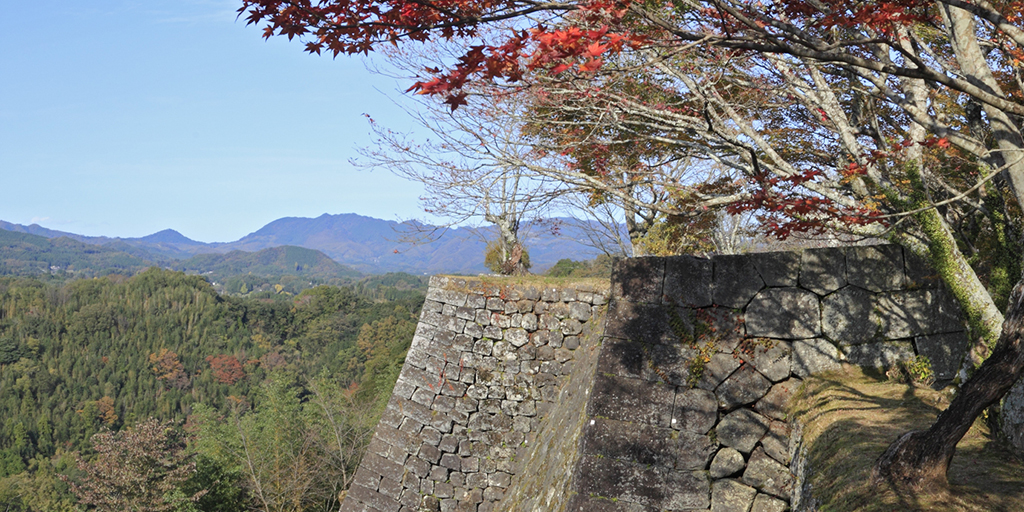History of Taketa

Ancient Toyo Province – Bungo
The landscape around Taketa is formed from layers of ashes and stones from the ancient eruptions of nearby Mount Aso. It is known to have erupted four times in the past. The most recent layer of ashes was deposited about 90,000 years ago.
The name Taketa means “bamboo field”
When people first settled there, that was their initial impression of the area. The entire region, including the Northern Fukuoka Prefecture, was originally designated as the “Toyo Province” by the Emperor Keiko. It means “prosperous land”. It has always been known for its good quality of life. In the 7th century, Toyo Province was divided in two: Buzen and Bungo. Taketa, and most of what is now the Oita Prefecture, were located in Bungo.
The founding of Oka Castle
According to the Bungo Kokushi – the History Book of Bungo Province, 1803 – the history of Oka Castle goes back to 1185 to the time of Ogata Koreyoshi, a famous soldier. Ogata was expecting to be joined by Minamoto Yoshitune, who was in conflict with his half-brother, Minamoto Yoritomo, the founder of the Kamakura Shogunate. Ogata hoped to make an alliance with Yoshitsune so that together they could rule the entire island of Kyushu but the boat carrying Yoshitsune to Kyushu from the mainland was wrecked in a storm and he was drowned.
Shiga, the ruling family in Taketa and Otomo, the feudal lord of Bungo
Shiga Sadatomo was a relative of Otomo, the feudal lord of Bungo Province. In 1334, he expanded the Castle. It is located on the hilltop between the Inaba River and the Shirataki River where they merge. The town was founded next to the castle.
In the 16th century, Portuguese merchants and Christian missionaries began to arrive in Kyushu. The 21st feudal lord of Bungo, Otomo Sourin, a Buddhist, met the Spanish priest, Francisco de Xavier, adopted the name Don Francis, and became a Christian.
Chikayoshi, a member of the Shiga family, married a niece of Otomo Sourin when he was 18 years old. Under the influence of his wife he too became a Christian. The number of Christians in the region increased until the Edo central government banned Christianity and cut off all contact with the outside world.
Shiga Chikayoshi was a capable soldier and he successfully defended Oka Castle against a siege by an army of 35,000 men of the Shimazu clan, from what is now the Kagoshima Prefecture. Thanks to his military skill and its hilltop location, Oka Castle survived the siege and became known one of the three strongest Japanese castles of the time.
277 Years of the Nakagawa Family and the Oka Feudal Domain
In 1594, Nakagawa Hideshige came from Harima on the main land and established the Oka Feudal Domain in Taketa. He joined Tokugawa Ieyas and fought on the winning side at the Battle of Sekigahara (1600). This marked the beginning of the Edo Shogunate. The Nakagawa family ruled Taketa until 1871.
Nakagawa Hideshige re-planned the town. He moved houses from Tamarai and Sougawa, 2 km away from Taketa. The town was divided up according to professions. The Samurai and merchants were settled near the castle; there are temples in the western part, and workers in the centre of town. The form of the old town has not changed much and the original names of the streets remain.
Oka was an extremely prosperous clan, although their territory was actually rather small. Taketa produced 70,000 Goku (150kg) of rice a year. The quality of their rice and soya beans was very good and could be sold for high prices.
They also had the good fortune that Taketa lay on the road leading to Edo, so that many Daimyos and other important travellers passed through the town and stayed there.
Modernisation and Industrialisation
After the Meiji restoration, all feudal domains were abolished and the modern Prefectures were established. Oka Castle was razed to the ground and only a stone platform now remains. Since then, Taketa forms a part of the Oita Prefecture. In 1954, a larger Taketa-City was founded and the adjoining towns of Hagi, Kujuu and Naoiri were incorporated in 2005.